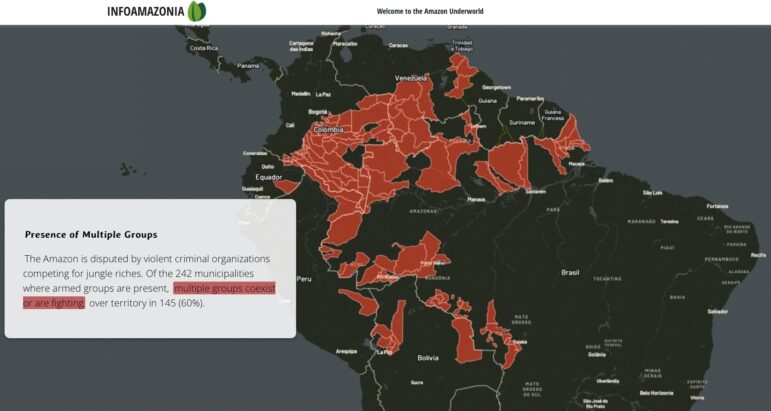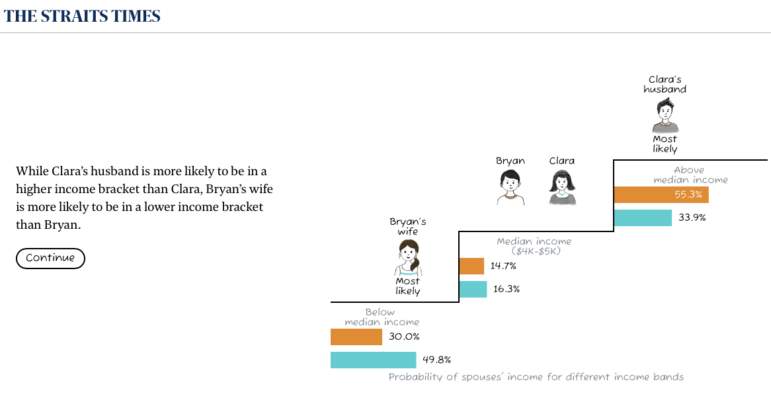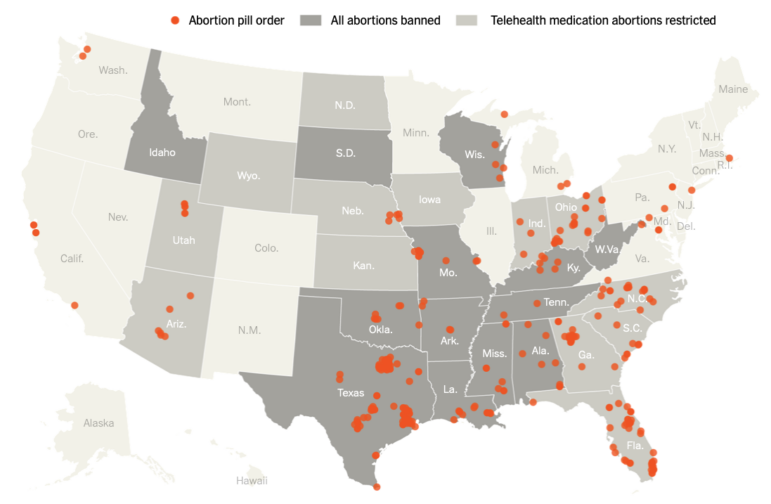

Image: Screenshot, Wall Street Journal
Data Journalism Top 10: How COVID-19 Changed the US, Race for the North Pole, and Visualizing Coronation in the UK

The Wall Street Journal did a deep data dive into how the COVID-19 pandemic changed the habits of people in the United States. Image: Screenshot, The Wall Street Journal
The coronavirus pandemic is officially over, but in the United States, many things have changed since early 2020. This week, our Data Journalism Top 10 features The Wall Street Journal’s dive into the residual impact of COVID-19 on the daily lives of Americans, a look by the Straits Times into Singapore’s gold medal history at the Southeast Asian Games, and how data journalists considered the coronation of King Charles III in the UK. The top 10 items have been curated by GIJN, and feature stories from May 1 to 7, 2023, with a bonus item from May 8, since we couldn’t leave out a Pulitzer Prize.
Everything Has Changed
The World Health Organization has officially declared the end of the COVID-19 crisis, but the pandemic continues to have an impact, affecting everything from how often people in the US visit their doctor to where they live, how they shop for groceries as well as their happiness levels. The data team at the Journal used maps, charts, and data to take stock of the socio-demographic impact of the coronavirus and associated lockdowns and restrictions, to chart how the lingering side effects are “reshaping American life.”
Going for Gold
The latest Southeast Asian Games — currently taking place in Cambodia — have been good for Singapore, with the women’s 4 x 100-meter freestyle relay swim team winning the country’s 1,000th gold. The data reporters at the Straits Times took a look through the medals archive of this regional “sporting powerhouse” to chart the best years and to interrogate the country’s greatest successes (spoiler: many of them have been in the pool).
Data Journalism Pulitzer for Chalabi
The data journalist and illustrator Mona Chalabi won a Pulitzer Prize for illustrated reporting and commentary this week. Her prize-winning project for The New York Times visualized the wealth of Amazon founder Jeff Bezos, who is pictured regal in crown and cape atop a pile of cardboard Amazon boxes. The jury praised her use of “striking illustrations” and “keen analysis” to compare Bezos’ wealth to that of an ordinary American, to show what Bezos could accomplish if he gave away more “of his cake,” and how his wealth has grown steadily over time, especially during the pandemic.
Coronation Fever?
Despite a series of royal scandals, the UK still doesn’t have that many Republicans, which, in that country, refers to the political movement to end the monarchy. But the coronation of King Charles III provided an opportunity for openDemocracy to dig into how much local councils spent celebrating with parties and fireworks — readers can search for their local authority and see how it compares to big spenders such as the London borough of Barking and Dagenham. Elsewhere, The Washington Post ran a quiz to test your royal knowledge (sample question: Does the monarch own all the UK’s wild swans?), while the South China Morning Post created a graphic exploring the rituals of the day, mapping the Commonwealth, and the line of succession.
Inequity By Design: COVID Vaccines in Venezuela
Coronavirus vaccines were first rolled out across Venezuela two years ago. But when reporters at the outlet Prodavinci analyzed the list of approved COVID-19 vaccination centers and pharmacies, they found huge geographic disparities in access. Using data from the health ministry, they discovered that only 436 out of the country’s 1,140 districts had a vaccination center, meaning residents in some regions would have to travel long distances to get inoculated. “Unequal distribution also affected districts particularly vulnerable to COVID-19,” they wrote. The piece was reported in Spanish, but there is an English summary on the site of the Pulitzer Center, which backed the project.
Forest to Farmland in the Amazon
The latest data project from InfoAmazonia, an independent geo-journalism organization, revealed more bad news from the Amazon. According to their analysis (published in Portuguese), between 2018 and 2021, an average of 38,000 hectares of farmland were developed on Indigenous land that was once forested, almost triple the amount registered annually between 2014 and 2017. Reporters charted the changes by year and created a number of maps to show how areas of farmland and pasture have crept over Indigenous lands. Investigative reporter Fábio Bispo wrote an explainer (also in Portuguese) of how they did it.
Hydropower Renaissance
Hydropower, long synonymous with huge engineering projects such as the Hoover Dam in the US or the Three Gorges Dam in China, is enjoying a renaissance. After a period where the environmental damage that dams can cause pushed hydropower into disfavor, pumped storage systems, in which water is stored in reservoirs at the top of a hill and produces energy when water is transferred to the bottom by turbine, are helping it make a comeback. Based on new research from the Global Energy Monitor, The New York Times mapped the spread of pumped storage projects around the world.
The Trials of Unsubscribing
Companies really do make it difficult to opt out of their services. To explore this phenomenon, a team at The Pudding signed up for 16 online services and tried to immediately unsubscribe, then documented the tricks employed (by all 16) to keep them subscribed — practices known as “dark patterns.” These include pop-ups about ad tracking cookies or countdown timers on shopping websites, but there are many more subtle ones to keep you signed up that are harder to spot — and sites offering free trials often employ the most egregious examples. (For a text story on the same issue, see this piece by Lenfest Institute)
Royal Color Palettes Throughout History
The women of the British royal family have mastered the art of visual communication through their clothing, according to a team at Axios, which analyzed thousands of photographs and visualized how Princess Diana; Queen Elizabeth II; Catherine, Princess of Wales; and Camilla, Queen Consort have used color historically. Princess Diana’s color palette — mostly pastels as she began her public life — changed after her separation from Prince Charles, when she started wearing black; Queen Elizabeth II paired her stoic public persona with bright colors; and Catherine is fond of “flag dressing” in shades of red, white, or blue.
Who Owns the Arctic?
The high Arctic has long been an “internationally neutral zone,” note the reporters at Bloomberg Green, but that era may be coming to an end, thanks to climate change and new strategic interests. Melting ice has carved out new shipping routes and opened the possibilities of resource extraction, and the isolation of Russia — the largest Arctic state — following its invasion of Ukraine threatens to upend the cooperation over its stewardship. Bloomberg visualized four countries’ competing claims over the area and its resourcse — and how maps might be redrawn.
Bonus Item: Met Gala Looks in Maps
The Met Gala — an annual fundraiser for the benefit of the Metropolitan Museum of Art’s Costume Institute in New York City — is also known as “fashion’s biggest night out.” The showcase event is covered by fashion journalists everywhere, but also this year by the Paris-based cartographer Jules Grandin, who saw celestial constellations, mountain regions, and universal hydrographic inspirations behind many of the designs. A dynamic, visual thread.
GIJN’s Data Journalism Top 10 list is curated weekly. Send your suggestions to us.
 Laura Dixon is an associate editor at GIJN and a freelance journalist from the UK. She has reported from Colombia, the US, and Mexico, and her work has been published by The Times, The Washington Post, and The Atlantic. She has received fellowships from the IWMF and the Pulitzer Center.
Laura Dixon is an associate editor at GIJN and a freelance journalist from the UK. She has reported from Colombia, the US, and Mexico, and her work has been published by The Times, The Washington Post, and The Atlantic. She has received fellowships from the IWMF and the Pulitzer Center.
 Alexa van Sickle is an associate editor at GIJN. She was previously a senior editor for the foreign correspondence magazine Roads and Kingdoms. She has also been an editor at the International Institute for Strategic Studies and a publisher at an international law non-profit in London. She lives in Vienna, Austria.
Alexa van Sickle is an associate editor at GIJN. She was previously a senior editor for the foreign correspondence magazine Roads and Kingdoms. She has also been an editor at the International Institute for Strategic Studies and a publisher at an international law non-profit in London. She lives in Vienna, Austria.
 Eunice Au is GIJN’s global team manager based in Budapest, Hungary. Previously, she was a Malaysia correspondent for Singapore’s The Straits Times, and a journalist at Malaysia’s New Straits Times. She has also written for The Sun, Malaysian Today, and MadamChair.
Eunice Au is GIJN’s global team manager based in Budapest, Hungary. Previously, she was a Malaysia correspondent for Singapore’s The Straits Times, and a journalist at Malaysia’s New Straits Times. She has also written for The Sun, Malaysian Today, and MadamChair.









